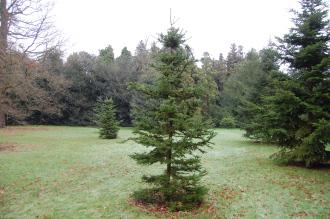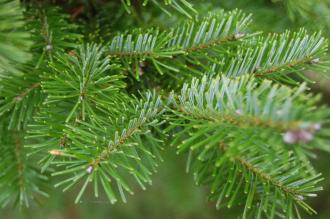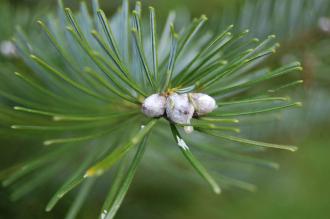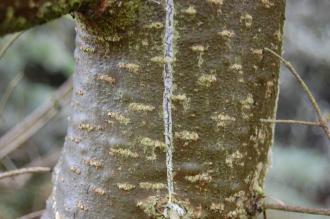
Abies sachalinensis (30/12/14, Kew Gardens, London)
Position: Full sun to shade
Flowering period: Spring
Soil: Moist, well drained
Eventual Height: 30m
Eventual Spread: 10m
Hardiness: 5a, 5b, 6a, 6b, 7a, 7b, 8a, 8b, 9a
Family: Pinaceae

Abies sachalinensis Leaf (30/12/14, Kew Gardens, London)
Abies sachalinensis is a slow growing evergreen coniferous tree with a conical habit. Its mid green aromatic leaves are needle like, flattened with a pointed tip, up to 3.5cm long and 1.5mm broad. Its trunk may achieve a diameter of up to 50cm. Its gray bark is smooth. Its male flowers are pale yellow pollen cones. Its fruit are cylindrical cones, up to 8cm long, 3cm broad, blue/ brown when young, maturing brown.
Abies sachalinensis, commonly known as Sakhalin Fir, is native to the far eastern islands of Russia and north Japan. In its native habitat it grows in in mixed mountain woodland from sea level to 1600m.

Abies sachalinensis Buds (30/12/14, Kew Gardens, London)
The etymological root of the binomial name Abies is derived from the ancient Latin name for the Fir tree. Sachalinensis is name after the island of Sakhalin, from where this tree was first discovered.
When available the landscape architect may find Abies sachalinensis useful as an attractive ornamental evergreen tree suitable for shady or dappled shade conditions.

Abies sachalinensis Bark (30/12/14, Kew Gardens, London)
Ecologically, Abies sachalinensis seeds are attractive to some birds.
Abies sachalinensis prefers moist, fertile, well-drained soils. It prefers an acid to neutral pH of soil.
Abies sachalinensis requires little maintenance.

